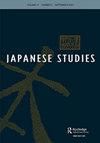A Celebrity’s Fifteen-Year Reign and Reinvention of Kamigata Rakugo
IF 0.4
Q3 AREA STUDIES
引用次数: 0
Abstract
Abstract From 2004 to 2017, Kamigata Rakugo Kyōkai (KRK) – the professional comic storytelling guild for the Osaka area – issued the magazine Nna aho na (That’s ridiculous). Concurrent with the tenure of one of the art’s most recognisable and progressive artists, Katsura Bunshi VI (b. 1943), as KRK chairperson, the magazine hailed Kamigata rakugo’s ‘new era’. It heralded the first dedicated rakugo hall open in Osaka in 60 years, as well as several other big-ticket enterprises. Nna aho na presented a brassy campaign of building and monument erection teamed with pageants and re-enactments of history, displays of tradition, and ritual. These served to promote Kamigata rakugo as a venerable art and one worthy of official recognition by Japan’s government. Examining the reforms that Bunshi VI orchestrated in the early twenty-first century, one sees a tension between ‘traditional’ and ‘new’ negotiated through an expedient trade-off. KRK was able to use Bunshi VI’s considerable star power to improve the art’s exposure, status, and infrastructure, while he became the face of the art, advanced his own agenda, and cemented his name in rakugo history.一位名人的15年统治与神方乐苟的重塑
摘要2004年至2017年,大阪地区的专业漫画讲故事协会Kamigata Rakugo Kyōkai(KRK)发行了《Nna aho na》杂志(太荒谬了)。在艺术界最知名、最进步的艺术家之一Katsura Bunshi VI(生于1943年)担任KRK主席的同时,该杂志称赞Kamigata rakugo的“新时代”。它预示着60年来大阪第一个专门的rakugo大厅以及其他几家大型票务企业开业。Nna aho na举办了一场黄铜色的建筑和纪念碑竖立活动,同时举办了庆典和历史重演、传统展示和仪式。这些都促进了Kamigata rakugo作为一种古老的艺术,值得日本政府的官方认可。考察本世六世在21世纪初策划的改革,我们可以看到通过权宜的权衡谈判达成的“传统”和“新”之间的紧张关系。KRK能够利用Bunshi VI的巨大明星力量来提高艺术的曝光率、地位和基础设施,同时他成为了艺术的代言人,推进了自己的议程,并巩固了自己在rakugo历史上的声誉。
本文章由计算机程序翻译,如有差异,请以英文原文为准。
求助全文
约1分钟内获得全文
求助全文

 求助内容:
求助内容: 应助结果提醒方式:
应助结果提醒方式:


